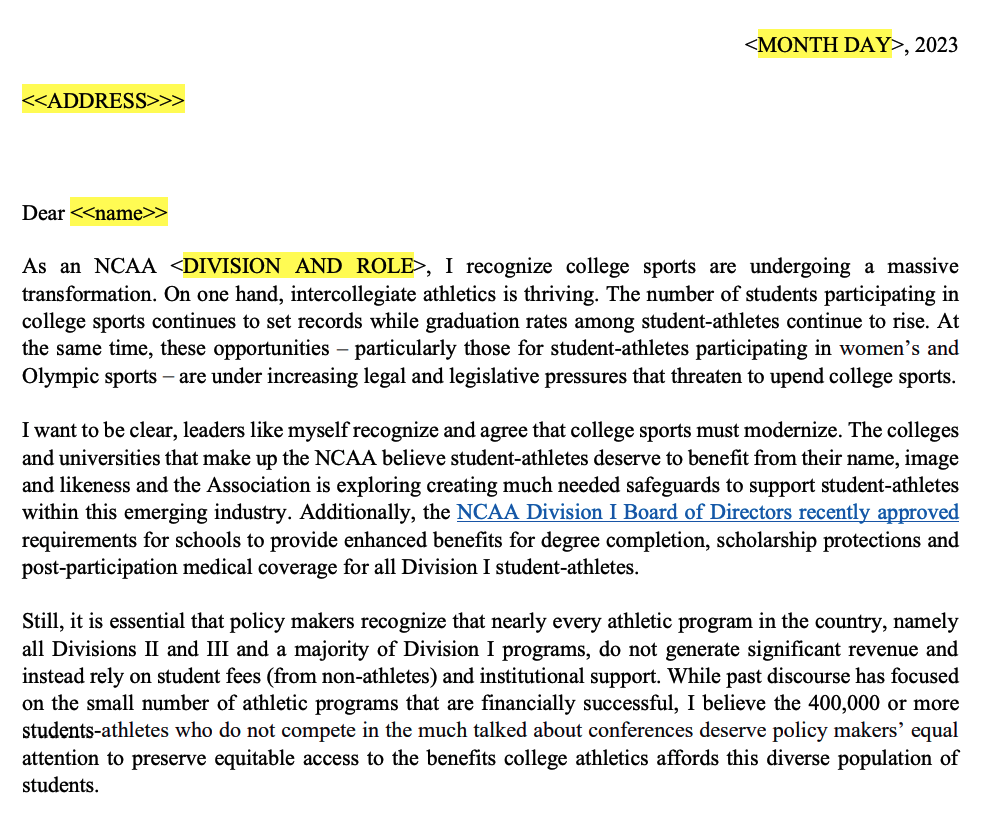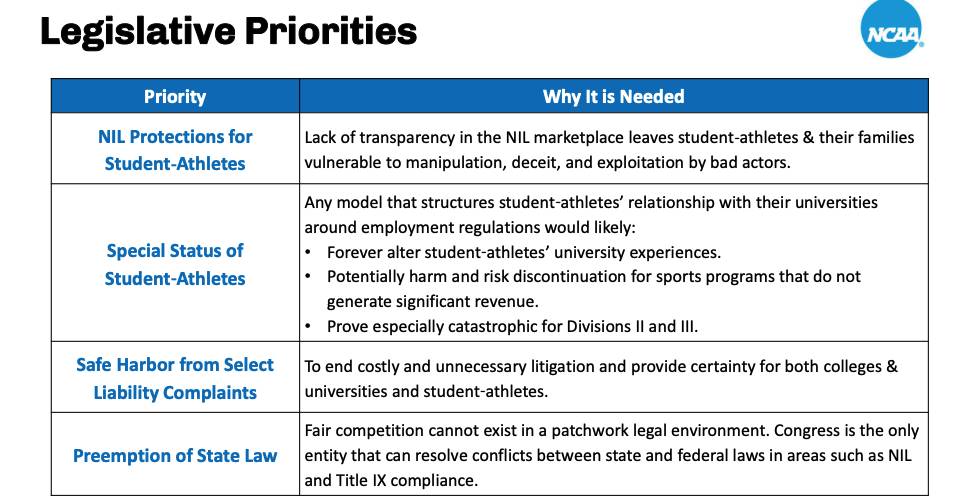NCAA's NIL lobbying strategy calls for unity, yet messages vary

On3 has obtained a series of memos and toolkits that provide a window into the NCAA‘s strategy – from the national office to the membership – of actively lobbying for federal legislation that regulates NIL activities and prevents athletes from becoming employees.
Due to the scope of the NCAA’s membership, there are inherent conflicts in the goals and resources of its conferences, schools and athletes across all three divisions. That extends to the crafting of legislation – both within NCAA governance or federally – that attempts to serve everyone in the enterprise.
“Unity will be key to success,” states one sentence in each division’s toolkit.
However, the talking points contained in the division-specific toolkits also offer some variations in order to cater to the NCAA’s desired talking points to their specific audiences. NCAA talking points recommend telling members of Congress the unintended consequences that college sports reform could have on Divisions II and III.
The NCAA’s strategy emphasizes maintaining future opportunities for women, Olympic-sport athletes and D-II and D-III athletes.
Its strategy also includes using current college athletes as messengers.
One slide in the NCAA’s D-II toolkit seemingly addressed college athletes directly, telling them, “There are many misconceptions out there about the student-athlete experience. YOUR story, YOUR perspective and YOUR experience matters to YOUR Congressional representatives.”
While NIL regulation is clearly a focus for the NCAA, it’s also arguably just an entry point. Each division’s toolkit says the NCAA membership’s legislative focus is “specifically NIL with the goal of opening the discussion on other priorities.”
The pressure is on.
The toolkit for each division references Congress’ upcoming August recess. The D-II toolkit said, “This is a critical window before political energy shifts toward the 2024 Presidential election.”
The NCAA is hosting two days of meetings on Tuesday and Wednesday in Indianapolis, where it invited numerous schools to recommend an athlete to attend. On3’s Eric Prisbell reported in early July that the D-I Working Group on NIL has been tasked with developing a Plan B. Additionally, members of Congress have created discussion drafts for or introduced at least six federal bills pertaining to college athletics in the last year.
However, none of the federal bills that preceded them even advanced to a vote.

NCAA open to exploring ‘unique economic interests’
Notably, one talking point provided in each division’s toolkit seemed to tease potential concessions that the NCAA could be willing to make to athletes in the highest-revenue-producing sports to achieve its Congressional goals.
“A small but important percentage of student-athletes compete in sports that generate significant revenue for their universities,” states the talking point. “With Congress’ assistance, we are open to exploring various mechanisms to potentially address these student-athletes’ unique economic interests in a way that is fair, equitable and sustainable.”
There weren’t any additional details provided in the slides regarding those potential mechanisms.
The NCAA wants Congress to prevent college athletes from becoming employees so “the interests of the small percentage of Division I student-athletes whose programs generate significant revenue can be addressed without profound unintended consequences for the half million student-athletes whose programs do not,” according to one slide featured in each toolkit.
NCAA: Employment would have ‘devastating’ effect
The documents that outline the lobbying and messaging strategy the NCAA is orchestrating periodically use the word “devastating” when describing athletes potentially becoming employees – although more frequently in the D-II and D-III toolkits than for D-I.
However, the potential devastation the NCAA describes isn’t limited to athletic opportunities. It extends to higher education at large – think about small, private colleges in particular – and in turn, small-town America.
The D-II and D-III toolkits state, “These Division II and III colleges are the beating hearts of many small towns across the United States,” such that turning their athletes into employees “would have devastating ripple effects not just on small colleges, but their surrounding communities.”
“What stood out to me when reading about that is whenever we see big changes, not just sports, but to general policy, we see apocalyptic kind of rhetoric,” said Dr. Katie Lever, a former Western Kentucky cross country and track and field runner who earned a Ph.D. from Texas in NCAA discourse with an emphasis on policy. “Where it’s like, ‘Oh, if this happens, then the sky is going to fall.'”
Thirty-three of the 44 pages in the D-I toolkit list all of the D-I conferences and their member schools, along with the members of Congress who represent each school’s home state, as well as their respective committees of jurisdiction. A different list of members of Congress provided in the D-III toolkit includes the alma maters for each member, as well as the sport they played in college if they’re former athletes.
NCAA provided a form letter in each toolkit
The NCAA also provided a form letter in each toolkit, highlighting areas where administrators can customize the letters intended for members of Congress with the specific date and each administrator’s name, role, institution and contact information.

“Presidential leadership is particularly important for this initiative as presidents and chancellors likely have existing relationships with Congress and can pull together the key resources on campus to discuss these matters,” NCAA Vice President of Division I Governance Kevin Lennon wrote on June 1 in an email to D-I presidents, chancellors and athletic directors.
The email linked to the D-I toolkit, as well as to a feedback form with a stated purpose “so the national office can coordinate member activity with Congress.” Lennon requested D-I administrators complete the form by June 15.
The form asked, in detail, if administrators reached out to their Congressional delegation and if not, then why not?
“The 30 different laws impacting college sports do not differentiate between division, so they impact every school,” an NCAA spokesperson said in a statement to On3. “None of those laws contain robust protection against exploitative behavior some student-athletes are unfortunately experiencing. The Association and the member schools believe college sports must transform to better serve all student-athletes.
“To do so, the Association has made several changes recently such as requiring student-athletes receive enhanced health care, mental health resources and academic protections and will continue to pursue additional supports for student-athletes going forward.”

Attempts to use college athletes to spread message
The slides also proposed questions to member schools, including one that promoted using college athletes to advocate for the NCAA’s interests.
One bullet point in each division’s toolkit states, “Which student-athletes on your campus can serve as key voices in sharing their experiences as a student-athlete with your community and federal legislatures?”
The D-II toolkit has a slide titled “How we are asking student-athletes to help.”
Another poses the question: “Do you, or one of your teammates, have an interest in using your social platform to highlight our efforts? Let your SAAC representative know!”
“They’re very openly admitting that they want to find people who are sympathetic to their views,” Lever said. “That line especially led me to believe that that whole document is just flimsy veiled propaganda. The NCAA is trying to find people who are going to openly voice support for them, which they’ve done with NIL hearings by finding SAAC athletes.”
Top 10
- 1New
Madness is undeway
First Four opens with thriller
- 2
Darian DeVries
Indiana set to hire WVU HC
- 3
EA Sports CFB 26
Doubles pay to players in appearing in game
- 4Hot
Jay Bilas
Reveals his bracket, upsets
- 5Trending
Mel Kiper
Mock Draft 3.0
Get the On3 Top 10 to your inbox every morning
By clicking "Subscribe to Newsletter", I agree to On3's Privacy Notice, Terms, and use of my personal information described therein.
The NCAA has promoted the letters that the Student-Athlete Advisory Committee at the D-I, D-II and D-III levels sent to Congress in June. The D-I SAAC letter, signed by former St. Bonaventure baseball player and current grad assistant Cody Shimp, claimed the committee “represents the nearly 190,000 student-athletes” who compete at the D-I level.
The D-I letter in particular received significant negative reactions online from some athlete advocates. It advocated for the NCAA to receive “safe harbor” from litigation and argued athletes shouldn’t be employees of their schools.
NCAA believes ‘Congress is the only entity’ to save it
On June 15, the NCAA Office of Government Relations provided a spring update to D-I, D-II and D-III conference commissioners, athletic directors, government relations representatives and a variety of other administrators.
Through a public records request, On3 obtained the update, which director Dawn Buth and assistant directors Patrick Lichtenstein and Sarah Vollaro each signed.
It stated, “NCAA schools and conferences are urged to engage their congressional delegations, sharing the threats to college sports, the urgent need for congressional action and the consequences of inaction.”
The talking points emphasize that the NCAA believes “Congress is the only entity that can stabilize college sports’ legal environment so that the NCAA can provide student-athletes with a fair, inclusive and fulfilling environment. As existing laws are currently being interpreted and applied, we cannot effectively regulate subjects like NIL and the employment status of student-athletes.”

Potential employment status of some athletes looms
The NCAA talking points suggest the employment status of athletes could potentially soon “differ wildly state-by-state,” similar to NIL legislation.
The NCAA encouraged D-I schools to discuss with their human resources and legal departments the potential impact on athletic departments of college athletes becoming employees.
The NCAA’s toolkits claim if one group of athletes, such as D-I football players, become employees, then “claims could be made that all student-athletes are employees.”
Subsequent bullet points argue that this would lead to the loss of sports sponsorship and opportunities to participate, less ability to recruit students and potential declines in enrollment.
Another talking point, which is only in the D-I toolkit, says athletes “would likely lose this control” over the number of hours they can spend at practice if they become employees. The NCAA cited its current limits on practice time.
The D-III toolkit stated, “Making all student-athletes employees, (sic) could result in student-athletes getting fired for poor performance.” Similar outcomes currently take place at the FBS level, particularly during the first year of a new coach’s tenure, such as at USC last offseason and Colorado this offseason, which is a practice protected by rule as long as schools still honor an athlete’s scholarship.
NCAA’s four goals for federal legislation
The NCAA talking points described what the toolkits define as “four narrow but critically important congressional legislative needs,” which are outlined below.
The first was summarized as “NIL protections for student-athletes.”
Both chambers of Congress are in session through July 28. Then, their recess begins. The Senate is in session starting Sept. 5. The House of Representatives isn’t in session again until Sept. 12.
By then, two-time reigning College Football Playoff champion Georgia, whose athletic department reported $203 million in revenue in 2022, will have played UT Martin ($11.8 million) and then Ball State ($28.5 million).
The NCAA’s lobbying strategy requires not just those disparate D-I schools to unify, but their D-II and D-III counterparts, too. Even if the NCAA can unite the bulk of its more than 1,100 member schools, it will need to convince Congress to do the same.
So far, that hasn’t happened.
“I see this as sort of a move by the NCAA where they’re using the last tools in their toolbox,” Lever said. “Like they’ve taken everything out. They’ve tried everything. They are really, really desperate right now.”
